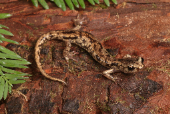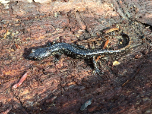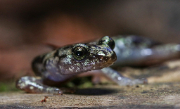Wandering Salamander (Aneides vagrans)
Description: The wandering salamander is very similar in appearance to the clouded salamander (Aneides ferreus) and was at one time considered to be the same species. It is long and slender and grows to a snout to vent length of 3 inches and a total length of 5 inches. The head is broader in males than in females. Between the nostrils and the mouth it has a pair of naso-labial grooves which are involved in chemoreception and it has sixteen costal grooves on either side of the body. The legs are relatively long and the toes have expanded terminal pads with square cut ends. The tail is prehensile and is round in cross section and used when the salamander clambers around among the branches of trees. The back varies in colour from brown to light grey, mottled or marbled and speckled with bronze flecks. It sometimes has a greenish sheen. The juveniles have a bronze stripe down the spine.
Habitat: In California it inhabits a narrow coastal strip of forested land with redwood, Douglas fir, cedar and alder. It prefers clearings or forest edges and may be abundant in recently cleared areas with tree stumps, fallen trees and woody debris. In Vancouver Island it is more widely distributed. It occurs from sea level to 5,600 feet.
Range: The clouded salamander was traditionally thought to have a range that extended from northern California through Oregon and north to Vancouver Island, but it is absent from the state of Washington.
Found in these States:
CA
Diet: It feeds at night on small invertebrates such as ants, mites, adult beetles and their larvae, snails, springtails and woodlice.
Reproduction: Breeding takes place in spring and early summer. The female lays a clutch of six to nine eggs in some concealed location such as under bark. She guards them as they develop and they eventually hatch directly into miniature adult salamanders with no aquatic larval stage.
Status: Listed as Least Concern in view of its relatively wide distribution, tolerance of a degree of habitat modification and presumed large population.
»» Kingdom: Animalia - Animals
»» Phylum: Chordata - Chordates
»» Subphylum: Vertebrata - Vertebrates
»» Class: Amphibia - (Amphibians)
»» Order: Caudata - Salamanders
»» Family: Plethodontidae - Lungless Salamanders
»» Genus: Aneides
»» Species: Aneides vagrans - Wandering Salamander
This article uses material from the Wikipedia article "Wandering Salamander", which is released under the Creative Commons Attribution-Share-Alike License 3.0. Content may have been omitted from the original, but no content has been changed or extended.
|













